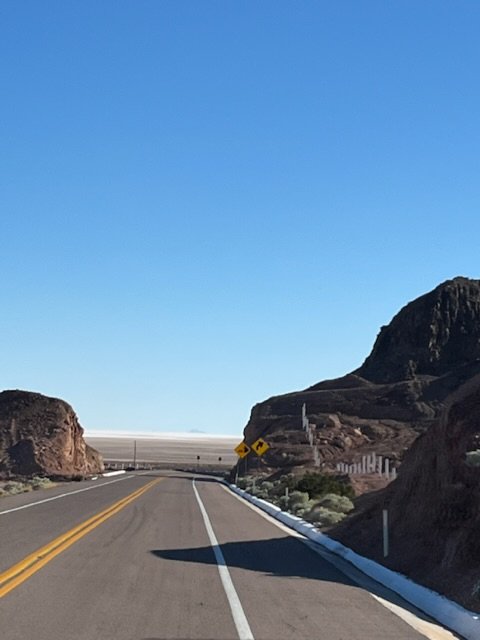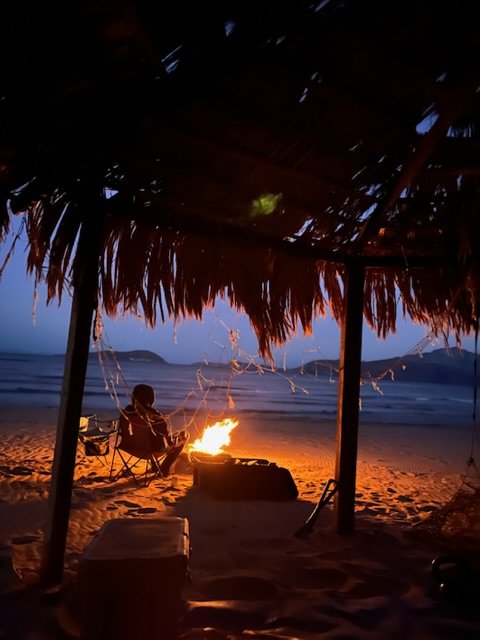Baja California- making our way south
In early November we returned from Asia, landing in Washington just in time for a fierce whidbey windstorm. Trees down. Roads a mess. Power out for days. We picked up the dog, paid some bills, packed up the paddle board and a kayak, swim suits, sleeping bags and a solar panel. Books, Notes and a map. And no solid plan.
Exploring the Baja California penninsula has been on our minds for years. Especially when the long stretch of winter grey sets in.
For two months we will join the snowbird nomads on the road. Homeschool/world school semester for Dylan, part 2.
We headed down the the Oregon coast, avoiding a snowy pass, south through the giant redwoods, pit stop in the Bay Area to visit family, then east to phoenix for a few days of fall ball and desert stars.
We cross the border at Tecate. A sleepy crossing east of TJ and west of Mexicali. We drive right through. The uniformed guards have guns carried upright—from their boots to their elbow. Intimidating. But they are friendly. After a quick inspection, fees paid, passports stamped, we are off…
From the US border to Lands End at Cabo San Lucas, the Baja Peninsula is roughly a thousand miles, depending on meandering side roads.
We head east and south. Toward The sea of Cortes. The gulf of California. Where the sea greets the morning sun.
One quick pit stop at a bank that wasn’t a bank becomes a wasted errand that is nearly costly. Just as we return to the highway gaining momentum we see the flashing lights. Policia. A second glance and moment of denial. Jon pulls over, hopefully to let them go by. Nope. Stopped in our tracks not 10 minutes into this journey. Thoughts swirl. Maybe we this was a bad idea. What are we doing here? This is not going well…
Jon is calm. The officer comes to my window and I greet him in Spanish. He smiles. He rattles on for a minute until, noticing my wide eyes, he slows. Poquito, I say. I speak sone Spanish but only a little. He smiles again and switches easily to English. He tells us that we made a right on red (apparently only sometimes okay)and we were blocking a crosswalk. To be fair we did not see a crosswalk under the thick layer of road dust. And there were no pedestrians. As for the right turn—there was no signage and we were in line behind several others(including 2 police cars) following their cue. (Clearly, our big van with Washington plates was an easy target). We don’t make excuses or protest. But I do subtly suggest that we will gladly heed a warning.
The officer asks if we have pesos. Hmm…. We do not. We tell him truthfully we have yet to find an ATM. He informs us unfortunately we have to go back and pay our fine immediately. “At the police station”. I grimace. Mentally preparing to alter our route and adjust our timeline. Again, he inquires we are sure we have no pesos? Hmmm…
I confirm and half- smile apologetically. He says “Ok. This time a warning. Be careful driving in Mexico and Have a nice trip!”
Deep breath. Pure relief…
Maybe we had done something wrong. Maybe not. Maybe he thought we might have some pesos to get out of a predicament. Doesn’t matter. Warning heeded. (Driving tip in Mexico- don’t always do as the locals do and don’t flash a big wad of cash when you pull out your license.)
We are back on the road. And it is still early.
On the outskirts of Mexicali We find a Pemex with diesel. And an ATM for cash. We drive past so many small tiendas and llanteras. Convenience stores and tire repair shops. Scroungey dogs roam the roadsides. The basura municipal (city dump) seems to stretch for miles south of town. Crooked branches loosely hold strings of barbed wire grabbing bits of trash blowing across the dusty roads.
The toll roads are in good shape. Very good. We get used to the road signs, and practice calculations—pesos to dollars, kilometers to miles— as we cruise our way south. sharing the road with almost nobody.
San Felipe is a dusty little seaside town. Far enough to feel like a getaway but close enough to the border to be accessible to anglers and spring breakers looking for a little funshine. The colorfully faded malecon speaks of a better year….
The supermarket is large and well stocked. We load up and pack the cooler with ice. Long stretches of soft sand beaches north and south of town are lined with drab motels, cinderblock construction unfinished and abandoned, and wind-blown palapas. RV parks with rigs clinging to their beachside spots like rusty weathered barnacles.
The paved roads are coated with fine white dusty sand. At a glance it’s hard to know they are even paved. Side roads are dirt and rutted. Crumbled concrete steps lead to the sea. There is nothing fast or fancy here in San Felipe. It’s a sleepy town and the locals speak at pace I can almost understand.
The malecon is a row of shops and street vendors on one side. A sidewalk and the sea on the other. Brightly painted signs are sun faded and peeling. The sidewalks are empty and tourist shops are hungry. A friendly shopkeeper beckons us in. His smile flashes gold molars as he peddles brightly striped blankets, ponchos, rigid dolls with painted faces, a swinging chair, a double hammock. He throws out prices then lowers them before we ask. Even lower, he says if we buy them now. He had us in the door. And he wants to keep us there. We left with one poncho. Dylan wears it now every day.
We camp at Las palapas. A little ramshackle rv park a mile or so from the malecon. It’s a small and simple. The hosts are welcoming. It’s down a sandy road on the outskirts of town. It’s beautifully beachfront with two story palapas. Painted blue and peeling. We put a chair on the upperdeck. But that’s probably all it can hold. The chair sits for the day empty. The campground isn’t busy but the sites are tight. Stray dogs circle us like vultures.
It’s a bit pricey for a camp. But the showers are clean and hot. The beach is long and beautiful. We collect shells and leave in the morning.
Continuing south we make our way through a long stretch of desert. Rolling hills of cactus scrub with a forbidding backdrop of parched peaks, hazy pink on the horizon. So many shades of muted greens. Some of the familiars I recognize—palo verde, yucca, cholla. Mesquite trees- strong, delicate and spikey- throwing just a tad of shade. A forest of ancient suguaro- tall and deeply grooved coulumnar giants. Stretching for miles in every direction. The rocky reddish- blonde soil carpeted in purple, a flower unidentifiable at our rolling highway speed.
We gaze at the monotonous yet ever changing landscape for hours. The diversity here might not be obvious at first glance, but Baja California is one of Mexicos richest regions of rare and endemic plant species. The low and high deserts, coastal and mountain geography are home to nearly 4000 species and varieties of plants. Roughly 1000 plants endemic to Baja California, occur only here. No houses, no tiendas, no gas. But far from desolate. Big trucks barrel past us on these just wide enough roads. We stop by a dry arroyo to make sandwiches. Dylan is on the lookout for yucca stalks. He uses them to make friction fire. Ocotillo makes an appearance. Then it is everywhere. Always my Sonoran favorite. Its long spiny branches reaching up and waving like antenae from a single base. Tiny leaflets of green along the branches reveals that water must have passed through not too long ago. Long stretches of dry and the leaflets shrivel. Then Ocotillo’s cousin, the otherworldly Baobab joins this desert gathering. Thickly truncked with a narrowing leafless column topped by wispy tufts of flower wands. Real world doctor Seuss. If it weren’t so dry here you might imagine you were under the sea.
As we drive we listen to Steinbeck’s, Log from the Sea of Cortez. As he and his crew make their way out on the water so many years ago, we make our way by land—toward the same enigmatic and alluring body of blue.
I wonder how much and how little has changed in so many years…
We pull into the hamlet of Bahía de Los Angeles. A local no frills fishing village. A few shops, a restaurant or two. Faded and Sandy. Stop signs that no one seems to notice. In front of the one market, a crew of military police in desert garb surrounds their pickup with long guns. Filling up their water tanks. Water is precious here. You get it where and when you can. They are casual and quiet. We walk past them to buy beans and salsa. And always more ice.
We make our way to Campo Archelon on the outskirts north of town.
Campo Archelon is a former sea turtle reasearch station now campground and cafe. Started by the father now run by his children. We snag a palapa on the beach, Park our van and set up home.
There is WiFi here. lattes and fresh fish tostadas. We are beachcombers in the morning. And again in the evening. We decorate our palapa with treasures from the shore. Rusty lanterns and shells, shiny car parts, old bouyeys and bits of braided rope. Jon even finds a washed up baseball sweatshirt just his size. The super amigos. Campeones from 2002-2006. Somehow Jon manages to find something baseball wherever we go…
The sunsets are incredible. Sunrises sublime. It’s not a view you want to leave. We stay a few days and soak up the quiet.
When the wind picks up we hit the road.











































































